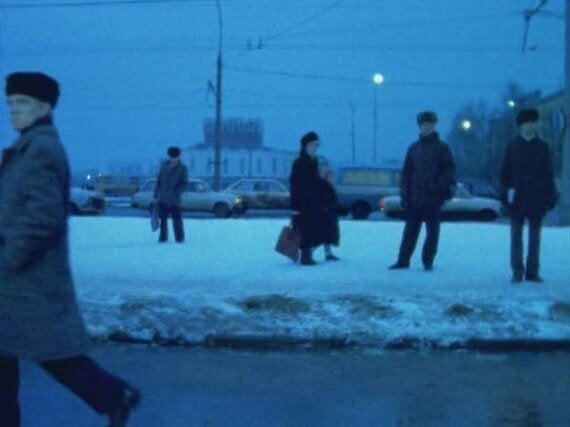I asked Chantal Akerman what kind of conversations she would typically have with dolly grips about tracking shots in her movies. What do you mean, she said, we use a car and shoot out of the window! I was astonished, but then Akerman resists the usual kind of conversations about film.

(Image courtesy of Paradise Films)
First of all, what is a 'dolly grip', in case you don't know what that it? A 'dolly' is the platform on wheels or whatever that runs along rails and allows the smooth movement of a heavy camera for film-making. The most famous dolly is the one supposedly invented by Fred Astaire and his team to follow his dance - in fact a huge dolly with complex crane contraption that allowed the camera to shoot low, or high, move forward and back as well as side to side, so that whatever he did the camera could follow (the image is the best that I could find of this contraption). The names of the dolly team on Top Hat are not credited on screen (you would need to see the call sheets stored somewhere in the RKO vaults to find that out), and yet the films are memorable because of the faultless work of the dolly grips, who judged the speed of the 'move-to-follow' (the phrase camera teams generally use), the coming to rest, the start of a move and the rhythm of it all to a tee. Oddly, seamless and choreographic movement of the camera such as this is becomes invisible because it is rooted in choreographed bodily movements.
What the camera sees and how it can move-to-follow was perhaps a familiar experience before even the advent of cinema, that is to anyone who has tried to conjure and hold an image in the mind - just close your eyes and imagine your walk to work. If a camera move is done well, we don't notice what a miracle it is. It is far from easy to move a camera around smoothly and in graceful fashion (at the time Top Hat was shot, a camera could weighed in at several hundredweight). It is just as far from easy to imagine walking around a vividly conceived cloister in a memory exercise, with reliably placed niches and corners which serve to trigger recall. The link between kinds of movement in these two realms seem to connect for me.
Moreover, that a movie camera moves for me evokes something of how the mind works - to hold something in the mind's eye is often to have to imagine a varying perspective on that thing. Still won't do.
Early cinema was intrigued by the 'phantom ride', the view from the front of a train or vehicle moving forward through the world. Such a subjective experience would have been most beguiling: an instantly comprehended filmic representation evoking a familiar first person movement through an environment. Indeed, speedy movement of a subjective point of view and a privileged world view are still the main sell that cinema has to offer.
But beyond such primitive, mesmeric allure, what about the movement of the camera? What if movement is not motivated by the demand to follow a human body in movement or to suggest a privileged spectatorship?
Chantal Akerman's work is far removed from that of Fred Astaire, of course. She is a single person, an auteur, a film-maker in complete charge of the process, deciding where the camera goes, what it sees, and what happens in front of it. Sometimes, she chooses even to appear in her own films. Mostly, her camera stays put, offering unblinking framing of spaces and entrances to spaces. Corridors and doorways are her frequent material. Akerman has, to generalise, been concerned with structuring what her stationary camera records. Perhaps budget constraints and artistic purposes happily coincided.
What of camera movement in Akerman's work? Hotel Monterey includes the suggestion of camera movement when shooting inside a lift reveals movement in the slit window of the lift as it ascends. Later, her camera creeps forward, then retreats in one of the narrow hotel corridors - a kind of 'phantom ride'. She panned the camera in one 360° shot then back in the reverse direction in La chambre. The camera reframes and holds choreographed movement in Les années 80 and Golden Eighties. The camera dollies in slightly in Le déménagement. While the camera is permitted its own motivation, not until her film D'est of 1993 would the camera become a protagonist, in the way that had become familiar as a trope of art house cinema in the later sixties and onwards. But as ever, Akerman is like no other film maker, and D'est moves seamlessly across genres, across modes of representation and without a bump into a new kind of cinema - one in which camera movement is central.
D'est is outwardly a 16mm documentary shot in Poland, East Germany (GDR) and the USSR, shot on trips taken as the Soviet system was about to collapse. Akerman has said she went 'while there was still time'. What kind of time, nor whose time, nor if there is any elsewhere (the suggestion may be that there is not!), I do not know. The film however avoids dialogue of any kind - though people often enough exchange words, they are not audible, and never subtitled. This is not silent film however, as the world is a noisy one, and one where cheesy pop music and stirring tunes play from speakers and loudspeakers. Dancing is allowed. The people in this film are seen to exist. We don't know their stories.
Akerman alternates between existence in public spaces and in private spaces. She alternates day and night. And she alternates static shots with moving shots - but not just any old travelling shots.
Akerman moves her camera along rows of people, along paths and lines. Her purpose is not narrative. If, for example, people are lined up waiting for a bus, then to travel along the line is not about narrative, though time and space are conflated - to wait is to be in a physical relationship with a row of others. To travel along that row of bodies is to discover the time invested. In other words, it is a narrative about waiting, a narrative we know that is about waiting for regime change, about ends of worlds, about existential uncertainty.
I suspect these sequences are haunted by the European memory of lines of people, not knowing where they are going, at the mercy of system that may have a final solution in mind. Railways can never be neutral in the European imagination, especially the imagination of a person whose mother was an Auschwitz survivor.
What is extraordinary about Akerman's travelling shots is that they do not lead to a reveal (the term is used by film folk to talk about a moment of discovery for the audience). Hollywood, with its concern with obstacles and the overcoming of obstacles seems to me to structure all movement as a search and a revealing discovery, while Akerman never builds to climax, or pay off. The movements are very even, without accent, and do not have the feeling of a movement towards or away from anything. To predict when they will end is a fool's errand.
Akerman has said she shoots from moving cars - and that may be why the view perpendicular to the direction of travel is the invariable condition of her travelling shots in D'est. But associations spring to mind for such shooting.
I think of tableau vivant, which describes a group of often costumed actors or models, posed and often theatrically lit. These figures do not speak or move. The set up is a collision of the stage and painting or photography. In this way, D'est can be seen as a reversion to the primitive and essential condition of cinema before film was invented.
I am also reminded of religious paintings and frescos in which the image must be read from left to right or right to left to produce a chronology of, say, a saintly life. Events are simultaneously represented and yet they are intended to be experienced sequentially, not as a series of discrete images and moments, but as an emotional journey through a familiar set of incarnations. The bodily movement required of the spectator is critical (a crab wise shimmy) - which, to me, is evoked when watching the moving shots in D'est - a sense of traversing.
A traverse - not the most familiar camera movement in film history. To traverse means to go sideways, not to confront ,or take control of, not to penetrate, not to withdraw. To traverse is to allow, to accept, to tolerate. To traverse is to move around the body of something that must be respected, that is not exactly a barrier but is not invaded. I like this move because it is - to veer into the metaphorical - feminine. It is as if clinging to something vast and unknowable, not to an object but to a feeling. There is always more...
No-one who appears in the shot is privileged, no-one in particular is picked out - all are equal, all are deserving, all are as real as any other. All are deserving of pity as any other. To put it another way - the movement, the film-making is democratic. When a cut to another shot comes, there is no correct moment to do that, though it always feels right in hindsight that a change has come. For D'est, Akerman was working with editors Claire Atherton and Agnés Bruckert. Every decision is the right one, and that in itself deserves attention.
It is a miracle of Akerman's films generally that she has never made an error of judgement about duration of shots or scenes. She may test patience and endurance but hind-sight always vindicates the decisions. Other film-makers may work with long, sustained shots, but as I see it, they are led by action that they have carefully designed, and carefully follow. Their purpose is narrative or expositional. They do not have such a subtle interest in the status of the film image itself and the structuring of experience. Nor does it seem relevant to me that others have made work in which every single shot is of great duration and which offers almost no overt narrative material (a recent favourite of mine is Unser täglich Brot by Nikolaus Geyrhalter), for this is not to work structurally but to embrace a certain aesthetic manner - which is a matter of tone not tune.
To go back to Astaire: he danced and his dance structured the world of Top Hat; Akerman structures the world and that is her dance.
D'est plays in the A Nos Amours Chantal Akerman retrospective at ICA London on 22nd January at 7pm.
Adam Roberts
